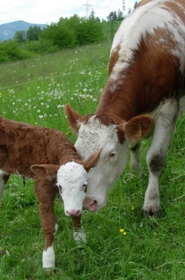Loss of horns is a genetically based characterisitc. The gene (named P) is genetically dominant versus the gene for horns (p). That implies polled calfes are possible although the gene is only beared by one parent. Below are some examples for inheritances.
 Dehorned cow and polled calf with typical round head (Auguste pp and Augenstern Pp)
Dehorned cow and polled calf with typical round head (Auguste pp and Augenstern Pp)
Inheritances:
Horned cow (pp) and homozygous poled sire (PP):
| P | P | |
| p | Pp | Pp |
| p | Pp | Pp |
The offsprings of such inheritances are always polled, but they carry one polled gene and one for horns (heterozygous polled).
Horned cow (pp) and heterozygous polled sire (Pp):
| P | p | |
| p | Pp | pp |
| p | Pp | pp |
50% of the progenies are horned, 50% are heterozygous polled.
Heterozygous polled cow (Pp) und homozygous polled sire (PP):
| P | P | |
| P | PP | PP |
| p | Pp | Pp |
The offsprings are polled in any case, 50% are heterozygous polled, 50% are homozygous polled.
Heterozygous polled cow (Pp) and heterozygous polled sire (Pp):
P |
p |
|
| P | PP | Pp |
| p | Pp | pp |
In this case 25% of the progenies are horned, 50% are heterozygous polled and another 25% are homozygous polled.
Tests for the polled gene
Meanwhile there are genetic tests available for testing the polled genetype. Another possibility, which was done earlier for sires, is to mate the sire with horned cows. As you can see above calves of a homozygous polled sire will always be polled.
Scurs (S) or (PS)- Epistatis
As mentioned above, there is a possibility that scurs are devolped, too. There is an interaction between the polled gene and the gene for scurs called epistasis. This means one ore more genes (in those case the gene for scurs) interacts with the phenotypic form of another gene. This results in the expression of scurs, although the animal is polled (it currently seems that most of the animals with scurs are heterozygous polled – we also made that observation, none of our homozygous cattle had scurs).
Scurs are horny growths without an osseous connection with the skull. Their size ranges from small crusts to horn like buildings with a lenght of few centimeters.Only polled cattle may have scurs. And there is a correlation between the sex of the cattle and the phenotypic expression of scurs. In female cattle scurs are only expressed if they bear the gene on both alleles (equivalent to the reccesive inheritance), in male cattles the gene is dominant.
In this table the expression of scurs, depending on the locus P and the sex, is described:
| genotype- horn* | Genotype – scurs | Phenotype- female | Phenotype- male |
| PP, Pp | SS | scurs | scurs |
| PP, Pp | Ss | polled | scurs |
| PP, Pp | ss | polled | polled |
| pp | SS, Ss, ss | horned | horned |
(S: dominant for scurs, s: recessive for scurs; * it seems mainly heterozygous polled cattle developed scurs).

